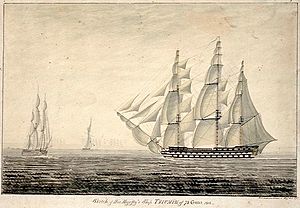HMS Triumph (1764) facts for kids

A sketch of HMS Triumph
|
|
Quick facts for kids History |
|
|---|---|
| Name | HMS Triumph |
| Ordered | 21 May 1757 |
| Builder | Woolwich Dockyard |
| Launched | 3 March 1764 |
| Fate | Broken up, 1850 |
| Notes |
|
| General characteristics | |
| Class and type | Valiant-class ship of the line |
| Tons burthen | 1825 (bm) |
| Length | 172 ft (52 m) (gundeck) |
| Beam | 49 ft 8 in (15.14 m) |
| Depth of hold | 22 ft 5 in (6.83 m) |
| Propulsion | Sails |
| Sail plan | Full-rigged ship |
| Armament |
|
Imagine a huge wooden warship, powered by sails and packed with cannons! That's what HMS Triumph was. She was a special kind of ship called a third-rate ship of the line in the Royal Navy. This means she was a powerful warship with 74 guns, designed to fight in a line formation during naval battles.
Triumph was built at Woolwich Dockyard in England and was officially launched on March 3, 1764.
Contents
Battles and Adventures
HMS Triumph saw plenty of action during her time at sea.
The Battle of Camperdown
In 1797, Triumph played a part in the exciting Battle of Camperdown. This was a big naval battle fought off the coast of the Netherlands. The British fleet, including Triumph, fought against the Dutch fleet. It was a major victory for the British!
The Battle of Cape Finisterre
Later, in 1805, Triumph was part of Admiral Calder's fleet. They were involved in the Battle of Cape Finisterre. This battle happened before the famous Battle of Trafalgar and was another important moment in naval history.
A Tricky Situation
In 1810, something unusual happened. Triumph and another ship, Phipps, were working together near Cadiz, Spain. They were trying to save a large amount of a shiny, liquid metal called mercury from a Spanish ship that had sunk.
Unfortunately, the containers holding the mercury broke open. This caused mercury vapor to spread through the ship. Some of the crew members became unwell because of this. It was a challenging time for everyone on board.
End of Service
After many years of service, Triumph was used for harbor duties starting in 1813. This means she stayed in port and didn't go out to sea for battles anymore. She was finally taken apart in 1850, ending her long and adventurous career.


